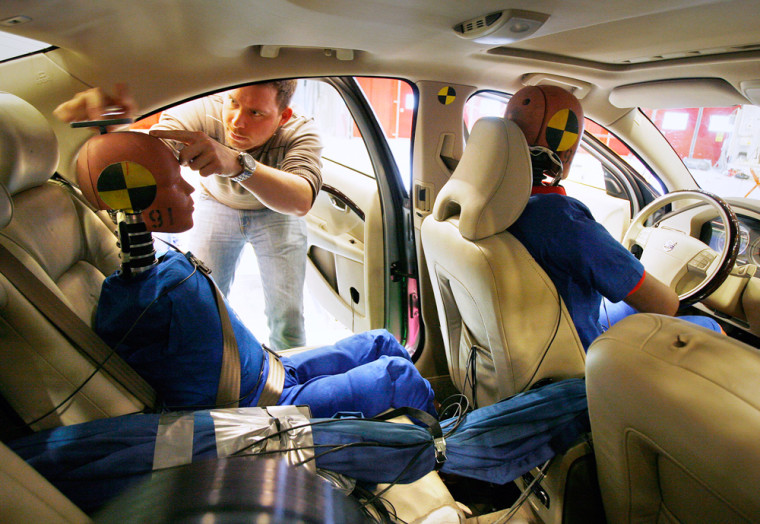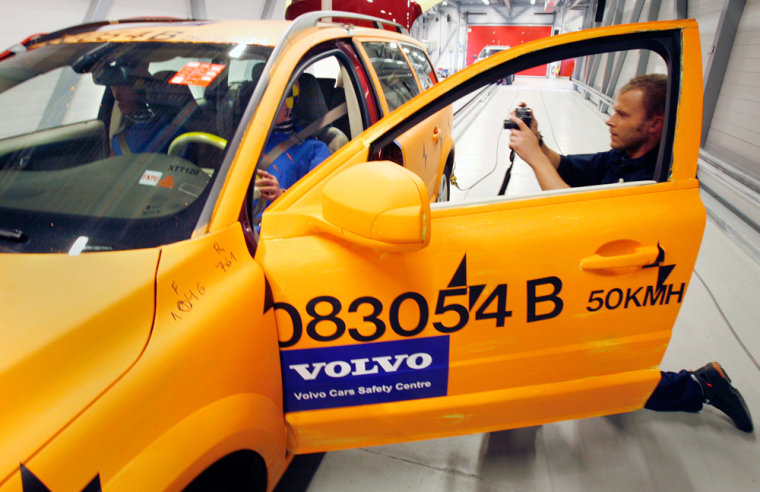The destruction of the orange sedan with its slapdash paintwork may have been intentional but it was far from wanton. It was all part of Volvo’s bid to create an injury-proof car by 2020.
While that vehicle of the future may lack the self-awareness of the crime-fighting Trans Am in 1980s TV series Knight Rider, experts say it will be able to steer, brake and find out about the road ahead from within a vast electronic bumper.
And if all goes according to plan, its driver and passengers will escape even the most serious crash unhurt.
Volvo is far from the only player in what Claes Tingvall, the Swedish road administration’s head of traffic safety, calls the biggest revolution in the auto industry since the seatbelt.
Automakers, parts suppliers, governments and global agencies from the United Nations to the OECD are all looking at ways to relegate to memory the roughly 1.2 million deaths and 50 million injuries caused by motor vehicle crashes each year.
But in what some analysts see as a bid to hold its lead in consumer perceptions of safety, the Swedish carmaker now owned by Ford is the first to set a target date to eliminate death and injury in its cars.
“I think if you look into the future, we as a community will not accept that we have injuries,” said Jan Ivarsson, leader of the Volvo safety team with specialists in everything from biomechanics to engineering to behavioral science.
“We have other things that are important in life.”
While Volvo is working on pedestrian safety as well, the 2020 goal centers on those inside its vehicles.
Tingvall, who is a force behind the Swedish government’s own plan to stop traffic deaths through better infrastructure, doubts Volvo’s target is fully achievable but said even a tenfold reduction in injury rates would yield dramatic benefits.
Borrowing principles from industries like aviation, the matrix of systems Volvo and other carmakers are working on will interact to start crash prevention and mitigation hours, rather than milliseconds, before impact.
Creative destruction
Which brings us back to the orange sedan, its nose crushed pug-small after powering down a tunnel at 35 miles an hour into an 850-tonne steel-encased block, at what analysts say is one of the most advanced crash-test centers in the world.

The Gothenburg complex’s moveable crash block and two 150-meter tunnels, including the only rotating test tunnel in the industry, allow Volvo to simulate everything from a head-on smash into a bus stop to a 90-degree vehicle-to-vehicle impact.
The rotating tunnel can also reverse and shoot a car outside, into the rock face or the pond behind the center.
As with many of the 400 crashes staged there each year, the test of a new engine configuration on the orange S80 — orange shows up well on video — took two weeks to set up, will take another two to analyze and was over in a 10th of a second.
It was filmed from all angles, including a glass-topped pit below, while sensors and painted rulers on the car, crash block and dummies yielded scores of measurements.
Volvo’s Ivarsson said the two male biomechanical measurement devices — we know them as crash-test dummies — would have walked off, if they could, with little more than bruises and broken ribs from what was by any gauge a significant smash.
Still, crash tests are only part of the puzzle.
The 20-member safety team also gathers real-world data from governments, insurance firms and, with a crash-site unit on 24-7 call, conducts its own field investigations into the causes of collisions and how they could have been prevented.
Christian Mueller, industry consultant at analysis firm Global Insight, believes Volvo needs the tonic of the 2020 goal.
The Swedish carmaker once sat comfortably at safety’s apex. Besides the three-point seatbelt invented by its then head of safety in the late 1950s, the firm also pioneered crumple zones, side impact air bags and rear-facing child seats.
It became emblematic of the U.S. “soccer mom” of the 1990s, who sought the steel cage to keep her children secure, and of Europe’s middle class who liked its solid predictability.
As recently as January, some 77 percent of U.S. consumers polled by Consumer Reports ranked Volvo as the safest car brand.
“No other brand dominates a category the way safety is owned by Volvo,” said Jeff Bartlett, Consumer Reports deputy online auto editor and author of the car brand perception survey.
But other carmakers have learned safety sells and are burnishing their own safe credentials, leaving Volvo with what Mueller calls a “huge” brand perception problem.
“Being safe is not any more the outstanding quality of Volvo because I can go elsewhere and I can buy a car that’s equally as safe,” he said.
There are signs this is getting through to consumers. A survey this year of German drivers by magazine Auto Motor und Sport gave Mercedes the edge on safety, although polls by partner magazines in France, Spain and Italy put Volvo on top.
“I think the competition must certainly be felt by Volvo but clearly they’re aiming to hold onto this lead in brand perception,” Bartlett said.
The automaker already offers ignitions that won’t operate if a driver is intoxicated, sensors that assess alertness and sound an alarm if the driver is dozy or drifting, and Global Positioning Systems to help prevent drivers from rushing to their destinations.
Should all this fail to avert a crash, the car takes steps such as tightening its seat belts and priming air bags to minimize injury.
The car of the future will have even more foresight.
Radar, sonar and other sensors will extend its so-called ”deformation zone” until it becomes, in essence, a huge electronic bumper reaching out on all sides to gather information to feed back to the vehicle.
In a crash situation, where many drivers freeze, the car will be able to take over and steer or brake on its own. Reducing pre-impact speed by 15 km an hour would halve the road-death rate, according to Tingvall, so self-braking is key.
In the very long run, Volvo’s Ivarsson said, we may all drive the ultimate vehicle: the uncrashable car.
“If you have a really long perspective, I think we will not have vehicles that will crash in the future,” he said. “You and I, in the future, we won’t accept that. Why should we accept that?”
